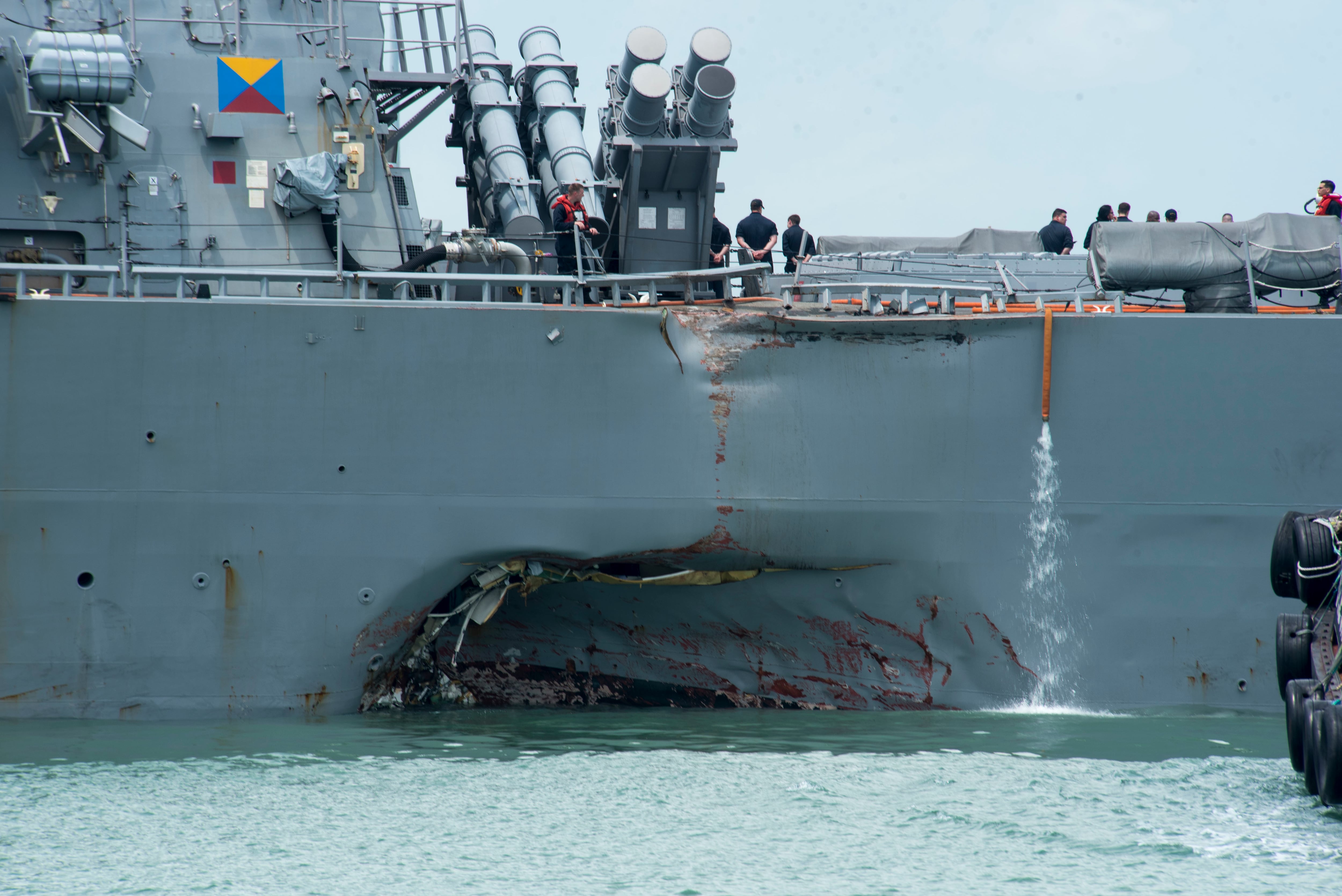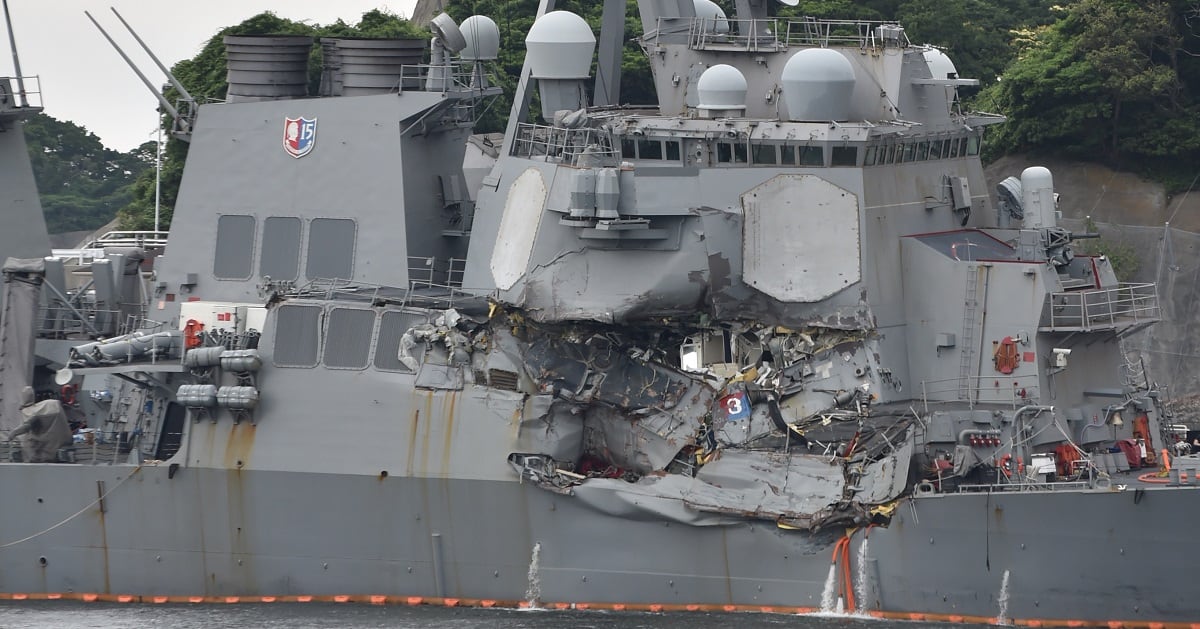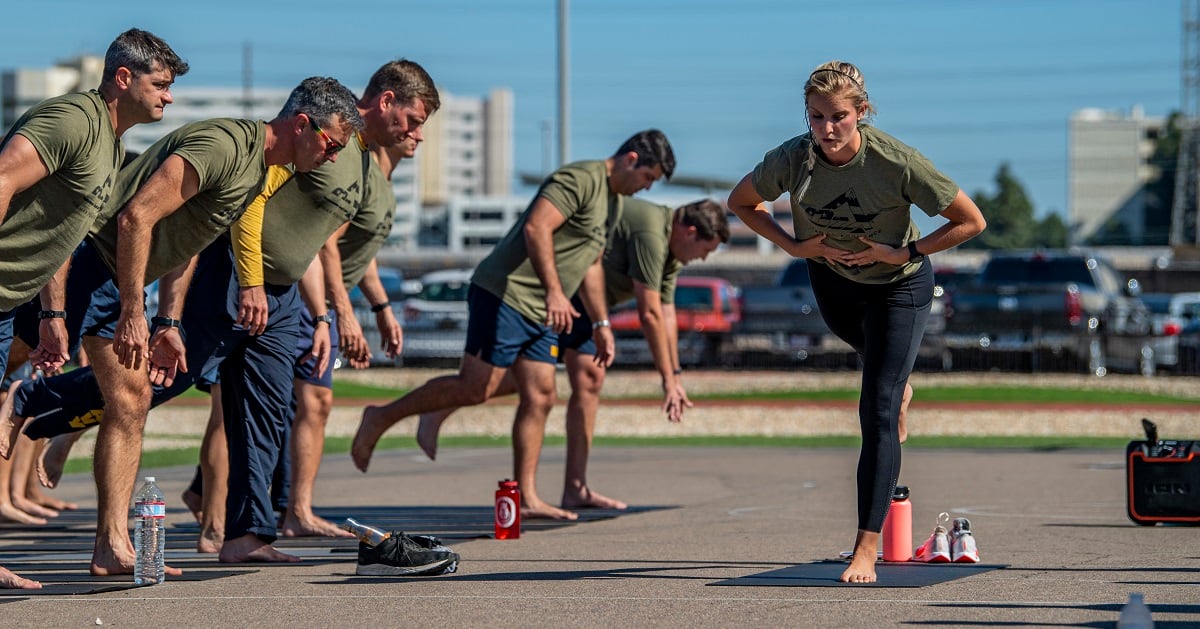WASHINGTON — After two catastrophic collisions in 2017, the U.S. Navy moved forward with dozens of recommendations meant to ensure it couldn’t happen again. But during this process, something became clear: Despite spending billions of dollars on readiness initiatives, the Navy’s mishap rate hadn’t improved in the last 30 years.
The service thought mishaps were down, but when accounting for a smaller fleet and fewer days at sea, the mishap rate was flat over time, according to Bud Couch, the operational safety officer for Naval Surface Forces.
Couch now helps lead the Human Factors Oversight Council, a group established in 2018 to examine the individual sailor’s readiness and how that can contribute to fleetwide safety.
The council is charged with finding answers to several questions: Is each team member properly rested and in a healthy place to contribute to the day’s operations? Was each team member brought to the ship sufficiently early in order to have enough time to adjust to the new team before performing potentially risky tasks? During the most dangerous evolutions, are the most experienced teammates at the helm, or is someone less experienced filling in?
Rather than continue to invest in readiness in the old ways, the team argues, diving into the specifics of those onboard as well as their experiences and physical readiness will yield better and more predictable results.
Fatigue and personal readiness
The Navy’s culture can push sailors to finish the mission, but medical research increasingly shows the ineffectiveness and even danger of working while exhausted.
“Sleep is critical in being able to make good decisions,” Couch said, noting it was a factor in the two 2017 collisions. On June 17, the destroyer Fitzgerald collided with the container ship ACX Crystal. The merchant ship ripped into the side of the Navy vessel, flooding berthing compartments, mangling the commanding officer’s stateroom and killing seven sailors. Two months later, the destroyer John S. McCain collided with the tanker Alnic MC. That Aug. 21 event killed 10 crew members.
The Human Factors Oversight Council found among sailors a “reluctance to report you’re fatigued because you want to get the job done,” Couch explained.
The Crew Readiness, Endurance and Watchstanding, or CREW, program — still in its pilot phase — gives sailors biological-monitoring devices like fitness watches and rings. Data from the devices are offloaded for medical staff and leadership to review and decide if someone is fatigued to the point of operating at a reduced capacity.
The human factors team has already identified a few devices that work best for this effort, and its members continue to refine how to offload the data to make real-time decisions, Couch said.
At the ship level, the CREW program will help a commanding officer “figure out if somebody is impaired due to fatigue or other factors so that we can make a smart choice about continuing or about replacements.” At the fleet level, Couch said, “we’ll have an impression ... of where folks stand with respect to fatigue for potentially operational commanders making decisions about how to employ the ship or when to pull them off the line” to return to port.
A follow-on effort to CREW is Optimal Watchbill Logistics, or OWL, which Couch said would plug fatigue data into a planning tool to help leadership determine “the best combination of folks to build our watch teams. And then if an issue comes up with one member of the team, what’s the most viable option to replace that person while they get rest or attention?”

Couch said the trucking industry in recent years has paid close attention to fatigue management and planning tools based on biometric data, and the Navy has been able to leverage some of that work for CREW and OWL.
“It’s just being aware that a member of the team is not at full capacity, or several members of the team are not at full capacity,” he said. “You could find somebody else who’s closer to full capacity, or you could just acknowledge that and then use better team skills, like making sure you’re checking in with people.”
The human factors team has run CREW pilot programs on several destroyers, littoral combat ships as well as an entire amphibious ready group and Marine expeditionary unit — or nearly 6,000 sailors and Marines across about 10 ships.
Couch said sailors were receptive to participating in the pilots since they got to keep the watches and rings. The team has focused on making sailors aware that fatigue isn’t a sign of weakness, but rather something that affects everyone.
The pilot will continue to run with more ships in the near term to refine algorithms and to start working through what it takes to get data to the right place in a timely manner. The ultimate goal is to establish a secure Bluetooth connection on the ship for automatic data transfer, and then for the data to go into Jupiter, the Navy’s enterprise data environment.
An operational risk alert
Among the recommendations following the 2017 collisions was a lofty goal: Use available data to determine when a ship is at risk of a safety mishap, such as a grounding or a collision. At the time, the Navy didn’t have the data repository or the analytics capability to make this a reality.
It took two years of work, but by the summer of 2020, outgoing Naval Surface Forces Commander Vice Adm. Rich Brown approved seed money to start the Operational Safety Information and Risk Indicator System, also called OSRI. OSRI leverages Jupiter, which launched in the spring of 2020.
“The ultimate goal of OSRI is to come up with this data-driven, risk-modeling effort that will cue us at the ship unit level that there’s a potential risk or vulnerability, and then be able to apply resources based on that cueing,” Couch said.
Though this effort is still a work in progress, the human factors team has spent the past year and a half identifying available data streams, determining which are important, and creating a picture of each ship’s cumulative risk and readiness.
The team has identified six data points that appear to be highly related to whether a ship is at risk of a mishap. Chief among them is a ship’s muster report that shows daily attendance on the job. Reviewing previous mishaps and near-miss events, the team discovered many involved a key billet where the most experienced person typically working on the ship was away, leaving a less experienced crewmate to fill in.
“For example, we had an event where the ship fired a high-explosive round over the top of another ship. And one of the key factors in that was that the gunner’s mate chief, who usually stood this watch in combat, was ashore,” Couch said. “It’s very, very common that some person who usually does something and has a great deal of experience was not present.”

Another data point involved mishaps during a ship’s maintenance phase. Certain types of mishaps during maintenance tend to correlate to mishaps at sea.
Other data points included manning levels — geared at examining the experience and education of individuals, how long they’ve been assigned to the ship, and how regularly they’ve been on the ship versus off the ship — as well as individual readiness factors like fatigue.
OSRI can also incorporate subjective information, including the results of afloat safety climate assessment surveys, which are periodically sent to ships’ crews.
The team now wants to use new artificial intelligence and machine-learning technologies to incorporate more data streams into the ship risk indicator system. For example, one individual casualty report from a ship might not paint much of a picture, but the totality of all the casualty reports over a period of time, combined with internal feedback from surveys as well as external feedback from training and assessment organizations, can help reveal a trend.
The team is also pursuing Project Hermes to apply natural language processing to verbal information and to help incorporate that as data into the risk indicator system. Ships send multiple messages a day about their material condition, fueling and spares status, personnel levels, operational activities, and more. Project Hermes would take these written messages, break them down into data and feed that into the risk matrix.
Better manning policies
Once complete, OSRI and these other efforts are meant to help leaders at all echelons make better decisions so no ship finds itself at risk of a mishap.
At the Naval Surface Forces level, the data will inform personnel policies. In recent years, the Navy has pulled sailors off ships in maintenance to fill empty billets for ships about to deploy. However, early data from the OSRI effort shows adding a new sailor to a crew just before deployment doesn’t drive down risk because it takes 90-180 days for a sailor to adjust to a new crew.
The data also indicates a noticeable uptick in risk when key sailors leave a ship during maintenance — meaning this past practice disadvantaged one ship to marginally improve another.
The human factors team hopes to use OSRI and other insights from its ongoing projects to model potential manning policies that would rule out harmful ideas, replacing them with ideas that raise the safety of the entire fleet. Service leaders can then use that data to craft more convincing budget justifications for the Pentagon and Congress.
At the deckplate level, Couch expects commanding officers to soon have tools to help plan routine and special operations while identifying gaps early, before the ship is in danger.
An individual risk matrix includes factors like fatigue, how long the sailor has been a member of the crew, the environmental conditions in which the ship is operating, the material condition of the ship, what operations the ship will conduct that day and more.
“Commanding officers, when they have the opportunity to brief [the commander of Naval Surface Forces, Vice Adm. Roy] Kitchener, on here’s how we’re going to tackle the basic phase or the maintenance phase, they’re much more granular in talking about exactly what sorts of people they need,” Couch said.
“The biggest outcome for us is that we’re no longer automatically willing to take somebody off a maintenance-phase ship to fix a ship at sea,” Couch added. “We can demonstrate now that’s just kicking a problem down the road, which we’re less willing to do.”
Megan Eckstein is the naval warfare reporter at Defense News. She has covered military news since 2009, with a focus on U.S. Navy and Marine Corps operations, acquisition programs and budgets. She has reported from four geographic fleets and is happiest when she’s filing stories from a ship. Megan is a University of Maryland alumna.









